
Can Music Improve Athletic Performance
More often than not, substances and supplements are typically the topic of discussion when researching the effects external elements have on sports performance. One area of study that provides some opportunity to gain a competitive advantage without the help of supplements and substances is music. The advantages of music in both physically and mentally exhaustive activities are often associated with the attempt to detach the individual from what they are engaged in (Priest). However, a number of studies have indicated that music can actually enhance the physical abilities and overall focus athletes need amidst performing. In some cases, the benefits have been so great that music has been dubbed as not a fair advantage, thus it has been banned during certain athletic events (Priest).
A great example of the effects of music can be seen in the manner in which it can allow the human psyche to truly focus on the exertions they are engaged in. For instance, prior to 2007 the New York Marathon began seeing that runners with music often were able to run faster and longer when listening to certain types of music. Runners found that running to a beat helped them moved their focus away from the fatigue and pain associated with long races. As a result they could use their mind to detach from such physical pains while continuing on in their endeavors (Priest). To battle the alleged advantage New York Marathon coordinators determined that it would be best to develop a complete ban on the use of music in competition. The ban would uphold both the prevention and disqualification of any runners caught using music during competition (Priest). The tendency is not only seen in runners, but other competitive athletes as well. A number of concepts and theories facilitate in the explanation of how music technically enables performance.
The first concept that explains the positive relationship between music and general performance is known as disassociation (Priest). Disassociation is a process that in which an individual detaches themselves from a particular activity (Goldstein). As mentioned previously, runners find that focusing on the music distracts their attention from the fatigue and pains of long distance running. This detachment from the physical aspect of athletics results in the elevation of mood, suppression of negative feelings and improved motivation. Studies on gym-goers even demonstrated that those using treadmills saw their fatigue drop by 10 percent when using music as an agent of disassociation (Priest). The same application can be seen with weight lifters and strength-based athletes. A focus on music allows them to detach just enough without losing focus on their actual movements, resulting in improved lifts (Jane Ellen Smith).
Another element that allows music to improve athletic performance is its ability to regulate arousal (Priest). Loud music that has a fast beat is often used to “pump” up those who are either preparing or in the middle of physical activity. It is described as such, “Music alters emotional and physiological arousal and can therefore be used prior to competition or training as a stimulant, or as a sedative to calm “up” or anxious feelings” (Priest). This tendency has been seen in a number of independent studies that measure overall muscle duration when participants are forced to hold a certain amount of weight for long bouts. The presence of upbeat and mood elevating music tended to improve performance in such cases (Priest). Thus if an active person finds themselves unable to muster up energy, music can serve as both a pre and intra-workout source of drive.
A final element that supports the notion that music improves sports performance is its ability to facilitate the synchronization of different movements for the subject engaged in the action (Priest). This seems to be most prevalent for athletes participating in repetition-oriented activities such as cycling, rowing and swimming (Bernie Williams). Nonetheless, similar cadences may be used in power-oriented sports, where music can stimulate this benefit (Bernie Williams). The synchronization that is supported by music essentially allows athletes to be more structured and less varied in their movements, so that error or poor form is minimized. Improved synchronization then turns into bolstered productivity and efficiency so that energy is utilized in a far more efficient manner. For example, a study on bicyclists showed a 7 percent decrease in the amount of oxygen required for events, when music was used (Priest). Another great example of the feats of synchronization through music is seen through world famous runner, Haile Gebrselassie, who has set world records while listening to “Scatman”. Other runners have also reflected a more general improvement when doing their 400-m spring, clocking in at -.5 seconds less when the proper music is present (Priest). Thus this demonstrates how and why synchronization through music can improve performance and even strength, when leveraged correctly.
In conclusion it is evident that music provides a myriad of benefits when taking part in athletic activities. They range from improving focus to detachment from less pleasurable exertions. In some cases the benefit is so great that sporting organizations have even chosen to ban its use. Thus it is effectively treated like a substance to an extent. With that said, building up a good playlist of workout music is certainly advisable, if a trainer or athlete wishes to take their skills and to the next level. Perhaps a few good songs can be the difference between mediocre and great.
Sources:
Priest, Costas Karageorghis and David-Lee. “Music in Sport and Exercise : An Update on Research and Application.” Brunel University (n.d.).
